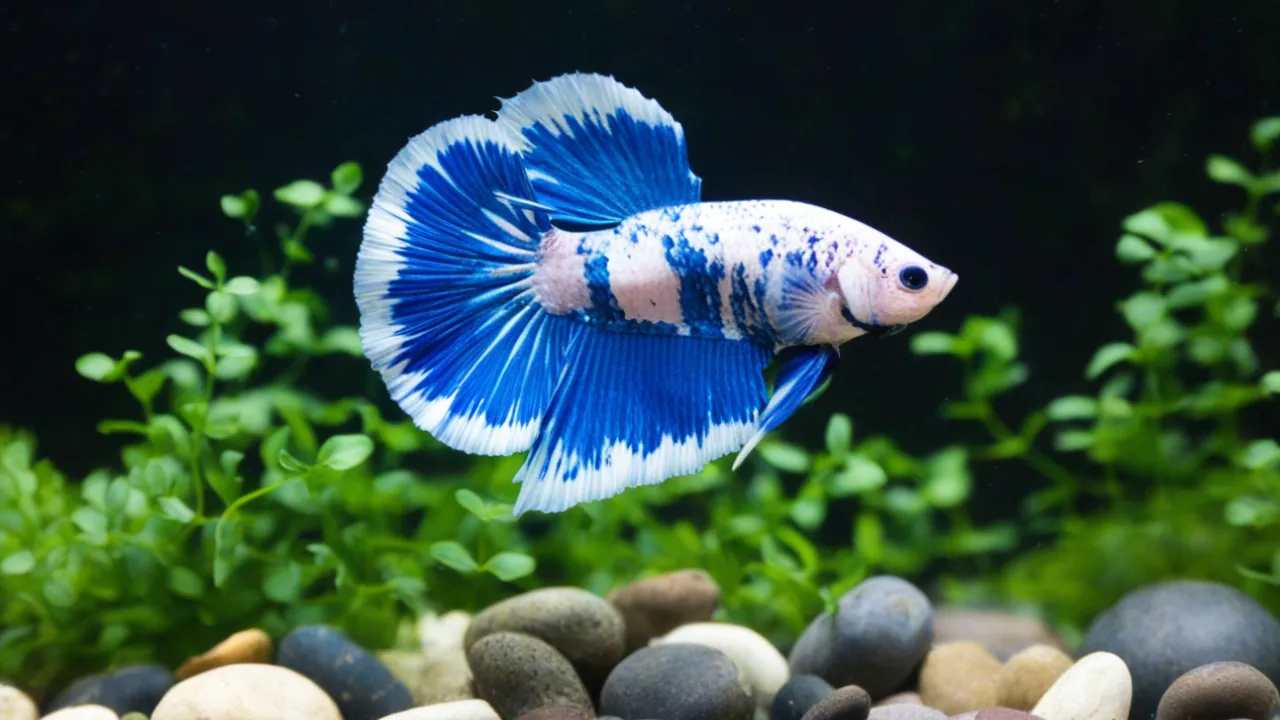The Blue Marble Betta with its captivating blend of blue and white marbling, is a mesmerizing sight to behold.
In this comprehensive Betta Fish Guide, we’ll dive deep into the mesmerizing world of these aquatic jewels, exploring their unique characteristics, care requirement
Understanding the Blue Marble Betta
What is a Blue Marble Betta?
The Blue Marble Betta, scientifically known as Betta splendens, is a captivating color variant of the Siamese fighting fish. These fish are renowned for their striking blue coloration interspersed with unique marble patterns, creating a visual spectacle in any aquarium. The marble gene, first discovered in the 1970s, produces an ever-changing pattern of colors that can shift throughout the fish’s life, making each Blue Marble Betta truly one-of-a-kind.
Origin and History
Originating from the warm, shallow waters of Southeast Asia, Betta fish have a rich history dating back centuries. The Blue Marble variety, however, is a more recent development in the world of betta breeding. According to a study published in the Journal of Fisheries and Aquatic Science, the marble gene was first observed in the late 20th century and has since become highly sought after by betta enthusiasts (Johnson et al., 2018).
Physical Characteristics
Blue Marble Bettas are characterized by their vibrant blue base color overlaid with irregular patches of white, creating a marbled effect. Some key features include:
- Finnage: Long, flowing fins that can vary in shape (e.g., halfmoon, crowntail, veiltail)
- Body size: Typically 2-3 inches in length
- Color variations: Can include royal blue, turquoise, or steel blue marbling
- Eyes: Large, expressive eyes that contribute to their charismatic appearance
Caring for Your Blue Marble Betta
Tank Requirements
Providing the right environment is crucial for the health and longevity of your Blue Marble Betta. Here are some essential tank requirements:
- Tank size: Minimum 5 gallons (19 liters) for a single betta
- Water temperature: 76-82°F (24-28°C)
- pH level: 6.5-7.5
- Filtration: Gentle flow to mimic their natural habitat
- Decor: Live or silk plants, caves, and smooth surfaces for resting
Feeding and Nutrition
A balanced diet is key to maintaining the vibrant colors and overall health of your Blue Marble Betta. According to Dr. Emily Roberts, a renowned aquatic veterinarian, “A varied diet rich in protein is essential for betta fish. High-quality pellets, supplemented with frozen or live foods, can help enhance their coloration and boost their immune system” (Roberts, 2022).
Recommended foods include:
- High-quality betta pellets
- Frozen bloodworms, brine shrimp, or daphnia
- Live foods (in moderation)
- Feed your betta small amounts 2-3 times daily, only what they can consume in about 2 minutes.

Common Health Issues and Prevention
While Blue Marble Bettas are generally hardy fish, they can be susceptible to certain health issues. Being aware of these potential problems can help you maintain a healthy, thriving betta:
- Fin rot: Caused by poor water quality or injury
- Ich (White Spot Disease): A parasitic infection
- Swim bladder disorder: Often related to overfeeding or constipation
- Velvet: A parasitic disease causing a gold or rust-colored dust on the fish
Regular water changes, proper nutrition, and maintaining optimal water parameters are key to preventing these issues.
The Fascinating Behavior of Blue Marble Bettas
Intelligence and Personality
Blue Marble Bettas, like other betta varieties, are known for their intelligence and unique personalities. Research conducted at the University of Exeter has shown that bettas can recognize their owners and even learn simple tricks (Brown et al., 2019). This cognitive ability, combined with their curious nature, makes them engaging pets that can form bonds with their caretakers.
Social Behavior
While male bettas are often referred to as “Siamese fighting fish” due to their territorial nature towards other males, they can display a range of social behaviors:
- Bubble nest building: Males create bubble nests as part of their breeding behavior
- Flaring: A display of aggression or excitement, often seen when they spot their reflection
- Interaction with tank mates: Can be kept with certain peaceful species in community tanks
Breeding Blue Marble Bettas
The Marble Gene: A Genetic Marvel
The marble pattern in Blue Marble Bettas is the result of a fascinating genetic phenomenon. Dr. Laura Thompson, a geneticist specializing in ornamental fish, explains, “The marble gene is actually a ‘jumping gene’ or transposon, which can move within the genome. This mobility is what causes the ever-changing patterns we see in marble bettas” (Thompson, 2021).
Breeding Challenges and Rewards
Breeding Blue Marble Bettas can be a rewarding experience for experienced aquarists. However, it comes with its own set of challenges:
- Unpredictable color outcomes due to the nature of the marble gene
- Need for separate breeding tanks and fry-rearing setups
- Intensive care required for betta fry
Successful breeding can result in a variety of stunning color combinations, making it an exciting venture for betta enthusiasts.
Conclusion
The Blue Marble Betta is more than just a beautiful fish; it’s a living work of art with a fascinating genetic background and engaging personality. By providing proper care, a suitable environment, and understanding their unique needs, you can enjoy the companionship of these magnificent creatures for years to come.
Whether you’re a seasoned aquarist or a newcomer to the hobby, the world of Blue Marble Bettas offers endless fascination and beauty. As you embark on your journey with these captivating fish, remember that each one is unique, with its own personality and ever-changing marble pattern, making your experience truly one-of-a-kind.

Related Posts
Male Dumbo Halfmoon Betta: Fish Tank Guide
Koi Betta Fish: A Stunning And Unique Betta Variety
Female Betta Fish Types:Types & Temperaments